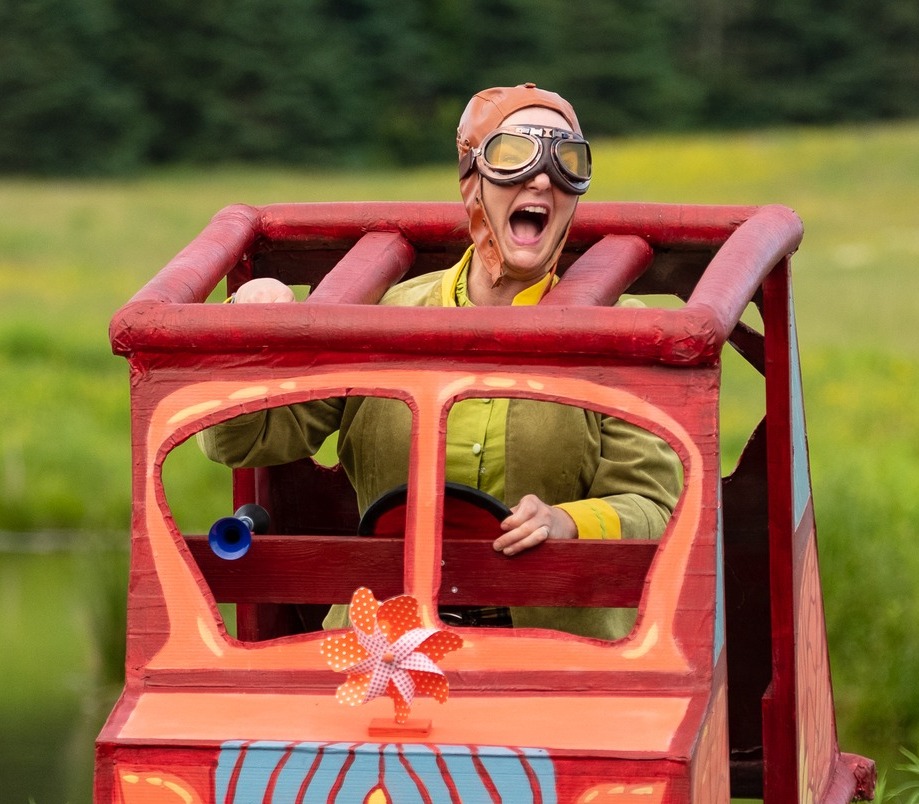
Burgandy Code as Toad in Wind in the Willows. Photo by Memo Calderon.
Sometimes I wonder if plays are chosen for Two Planks and a Passion Theatre in part by a conversation surrounding what character audiences will delight in seeing veteran actor Burgandy Code tackle next. “Toad” in a musical adaptation of Kenneth Grahame’s The Wind in the Willows is absolutely one of the many correct answers.
The Wind in the Willows is a novel for children first published in 1908. The book is a collection of short stories about a group of critters: Mole, Rat, Badger, Otter, and Toad who have quite a number of quaint adventures together, but the central narrative surrounds a more dramatic tale of Toad, boastful and wealthy, becoming obsessed with motorcars and making a menace of themselves, driving dangerously through the community and getting into a number of scrapes. The adaptation at Two Planks and a Passion written by Ken Schwartz (book and lyrics) and Allen Cole (music and lyrics), really captures the homey warmth that these stories evoke.
Ross Creek Centre for the Arts is ideally suited as the backdrop for this play. The audience sits facing a marshy duckpond, where one might easily expect to see a water vole, mole, or toad, and to the right of a beautiful field of tall wildflowers. There is a chorus of singing ducks in the play, and there were real ducks swimming in the pond as Henricus Gielis, as Mole, and Rosie Callaghan, as Rat, rowed in a real boat amongst them, singing and playing the guitar. At one point later in the play one of the real ducks made a cameo appearance. Like A.A. Milne’s Hundred Acre Wood Grahame gives his woodland critters a safe, cozy, idyllic home and community in nature. We see the clear metaphor in how it’s Toad’s obsession with technology (and power) that is constantly creating drama for everyone. It’s so apt for the play to be brought to life in the natural landscape of the North Mountain.
The music by Allen Cole and Ken Schwartz really reminded me of a Disney score, in that it struck a really great balance between some songs that were more musical theatre in nature, like Rat’s Boat Song, and Toad’s Car Song, and certainly Kih Becke’s eleven o’clock number as the court clerk, and then choral music that blends in more with the croaks of the frogs, and the sounds of the crickets, and, indeed, the wind through the grass and the flowers. The actors play all the instruments themselves, which also adds to the wholesome and magical nature of these little critters. A ji’kmaqn, a Mi’kmaw percussion instrument, is also used beautifully in the show, which helps to root this version of Grahame’s story specifically here in Mi’kma’ki.
The actors all give beautifully nuanced performances, with funny walks, and sniffs, vocal intonations, and ways they move their hands to really bring these various animals to life. Henricus Gielis’ Mole is extremely earnest and exuberant, and always up for an adventure. You really get the sense that in looking through Gielis’ eyeglasses you are experiencing everything in this moment for the very first wondrous time. Rosie Callaghan’s Rat is both Mole’s protector and the manager of his exuberance. She is a bit bossy, knows all the proper etiquette and is quite particular about it, but she is very goodhearted and a loyal friend. Callaghan does a lovely job of balancing Rat’s affection for her friends with her desire to also keep control of them. Chris O’Neill plays Otter, physically hilarious, a bit of a friendly gossip, but who is always quick to help her friends out in a jam. Michelle Fisk plays Badger, a sweet critter who would rather be left alone than dragged into other people’s shenanigans. Fisk gives a really beautiful performance of someone who needs to be nudged a bit into connecting with others, but once she does, she’s really very warm, wise, and extremely generous. Burgandy Code is both hilarious and delightful as the rapscallion Toad. Yes, Toad is selfish, and a nuisance, but it’s clear to see why her friends put up with her too. Code is so much fun to watch in this role; she radiates mischievous joy, and unrepentant silliness.
The story emerges out of this landscape so effortlessly, a testament to how well Ken Schwartz knows how to use this space so evocatively. There is also a lot of fun choreography, especially surrounding Toad’s motorcar. Kih Becke is the show’s Movement Director.
Diego Cavedon Dias’ costume design works beautifully with the music and the outdoor environment to create these critters in a way that isn’t entirely literal, but that captures the era in which the stories were written, a “down home” sort of riverside nostalgia, and a sense of enchantment around these animals who can talk, sing, and play their own instruments. I loved Toad’s motorcar, and the entire set by Holly Meyer-Dymny as well.
Wind in the Willows is a beautiful little play perfect for the entire family to enjoy. If you are familiar with these characters, I think you will be completely charmed by how this company has brought them all to life, and if it’s your introduction to them, I think it’s a very worthy one. This musical play feels like a classic in the making. I know Two Planks doesn’t often do remounts, but this feels like something families would keep coming back to see year after year. I certainly would.
The Wind in the Willows plays just twice more, on Friday August 18th and Saturday August 19th, both at 6:00pm, at Ross Creek Centre for the Arts (555 Ross Creek Road, Canning). For tickets and/or more information please visit this website.





 World Theatre Day: My God Is It Ever The Time to Invest in Canadian Plays
World Theatre Day: My God Is It Ever The Time to Invest in Canadian Plays 